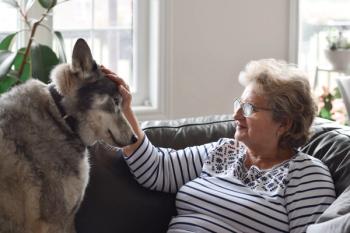
The pricing struggle: How high is too high for pet owners?
Our study suggests that when veterinary prices rise faster than the rate of inflation, consumers opt out of seeking services.
Shutterstock.comVeterinary pricing can be a confusing topic. After all, experts urged practice owners for years to raise their fees-and then suddenly everyone started wondering why client visits were dropping. No surprise: There may be a connection. We at the AVMA Economics Division recently delved into the question of how prices affect the demand for veterinary services in some depth.
There are currently two widely available veterinary price indexes: the Nationwide-Purdue Veterinary Price Index and the U.S. Bureau of Labor Statistics' (BLS) Veterinary Services Index. Until recently, these two sources appeared to contradict each other: The Nationwide-Purdue index showed prices falling until the beginning of 2015, while the BLS data showed prices increasing at a rate greater than inflation. To help get a better idea of how prices have been trending over time, we consulted another well-known resource on prices, The Veterinary Fee Reference published by AAHA.
To perform our analysis we gathered mean fees for selected services from the first through ninth editions of the AAHA reference, categorized them as either wellness or medical services, and calculated index values and compound annual growth rates. We included only commonly performed services that were similarly reported in the majority of editions, ending up with seven wellness services and 20 medical services in our final set. The wellness services were selected to reflect what's purchased during a typical canine wellness visit: physical exam, fecal analysis, heartworm test, nail trim, and rabies, distemper-parvo and Bordetella vaccines.
Mean and median values varied greatly for some services. To minimize the inconsistency between means and medians, we excluded services with greater than 20 percent difference. Changes in technology that occurred over this period-such as the introduction of the triennial canine rabies vaccine and the adoption of digital radiography-are reflected in the data, affecting the fee increases for those years.
How did the price indexes compare?
The AAHA prices on wellness services generally increased at a lower rate than prices listed in the BLS Veterinary Services Index but faster than inflation (as reflected by the consumer price index) until 2012 (Figure 1). After 2012, prices for wellness services increased at rates closer to the rate of inflation. It's worth noting that from 1998 until 2011, the number of pets not receiving care at a veterinary hospital increased and has remained at the same level since 2011. This suggests that rising prices at a rate greater than general inflation led to an increase in pets not visiting a veterinary hospital. Rising prices reached a point where demand was truncated-some pet owners no longer saw the value or could not afford the prices charged.
Source: AVMA Economics Division
Most interesting was the fact that overall prices for the AAHA wellness services increased at lower rates than for the AAHA medical services (the opposite of what the Nationwide-Purdue index shows), which were often found to mirror price increases from the BLS price index (Figure 2). Because wellness services are considered to be “shopped” and therefore more sensitive to price changes, practices appear to have understood that raising wellness service prices would have a greater negative impact on demand (or would be met with more resistance) than increasing prices of medical services.
Next page: What does this mean for veterinary practices?
Source: AVMA Economics Division
Impact on veterinary practices
What we're seeing here is that when prices increase, consumers respond. Some will pay the higher prices, while others will buy fewer services, switch to a lower-cost alternative or eliminate the service from their expenditures. If the rising prices have a relatively small impact on the number of services purchased (inelastic demand), total revenue will increase. If rising prices have a large impact on the number purchased (elastic demand), total revenue will decline.
Source: AVMA Economics Division
At some price point, increasing prices will no longer increase revenue because more clients will choose to spend less or not go to the veterinarian than can be compensated for by the higher prices being paid by remaining consumers. For every service or service bundle, there is a price point at which revenue is maximized. Previous studies have shown that the amount spent by pet owners at veterinary practices each year is not increasing, while the price indexes show that prices may be increasing at a rate higher than annual inflation. And the AVMA Pet Ownership and Demographic Survey illustrates that the number of pets not seeing a veterinarian has increased since the beginning of the price increases in the late 1990s. This could indicate that current prices have exceeded the revenue-maximizing price.
So how can practicing veterinarians use this information when deciding how much to increase prices next year? First, avoid the pitfall of assuming that increasing prices will always result in increased revenue. Instead, examine past trends to determine how changing prices have affected the number of transactions and average value of transactions. In general across the profession, prices and total revenue have increased while compliance (number of services) and number of active clients have dropped.
More importantly, profit showed no change from 2010 to 2014 and only recently has started to increase. This suggests that from 2010 to 2014 veterinary practices passed the price point where rising prices no longer increased profit. Any further attempt to raise prices above the rate of inflation will further reduce profit, and holding price increases below inflation will likely increase profit. Even better, maintaining price increases below the rate of inflation will also help to improve compliance and client visits, ensuring that more pets receive all the care that they need from veterinarians.
This and other information will be discussed at the
Dr. Rebecca Brake is an extern in the AVMA Economics Division. Dr. Michael Dicks is director of the division.
Newsletter
From exam room tips to practice management insights, get trusted veterinary news delivered straight to your inbox—subscribe to dvm360.




